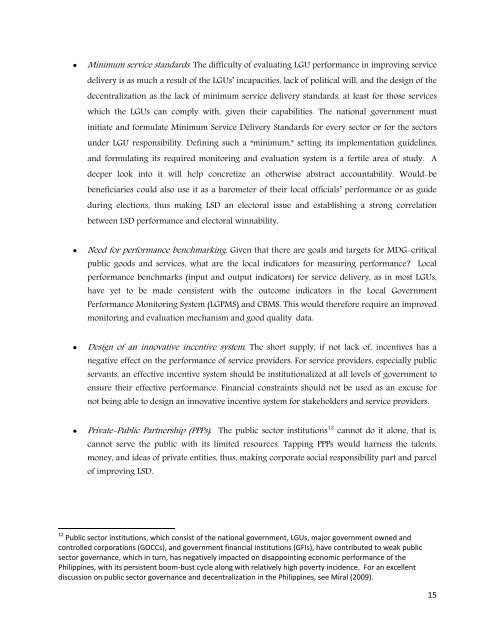Triangulation Framework for Local Service Delivery - Philippine ...
Triangulation Framework for Local Service Delivery - Philippine ...
Triangulation Framework for Local Service Delivery - Philippine ...
You also want an ePaper? Increase the reach of your titles
YUMPU automatically turns print PDFs into web optimized ePapers that Google loves.
• Minimum service standards. The difficulty of evaluating LGU per<strong>for</strong>mance in improving service<br />
delivery is as much a result of the LGUs’ incapacities, lack of political will, and the design of the<br />
decentralization as the lack of minimum service delivery standards, at least <strong>for</strong> those services<br />
which the LGUs can comply with, given their capabilities. The national government must<br />
initiate and <strong>for</strong>mulate Minimum <strong>Service</strong> <strong>Delivery</strong> Standards <strong>for</strong> every sector or <strong>for</strong> the sectors<br />
under LGU responsibility. Defining such a “minimum,” setting its implementation guidelines,<br />
and <strong>for</strong>mulating its required monitoring and evaluation system is a fertile area of study. A<br />
deeper look into it will help concretize an otherwise abstract accountability. Would-be<br />
beneficiaries could also use it as a barometer of their local officials’ per<strong>for</strong>mance or as guide<br />
during elections, thus making LSD an electoral issue and establishing a strong correlation<br />
between LSD per<strong>for</strong>mance and electoral winnability.<br />
• Need <strong>for</strong> per<strong>for</strong>mance benchmarking. Given that there are goals and targets <strong>for</strong> MDG-critical<br />
public goods and services, what are the local indicators <strong>for</strong> measuring per<strong>for</strong>mance <strong>Local</strong><br />
per<strong>for</strong>mance benchmarks (input and output indicators) <strong>for</strong> service delivery, as in most LGUs,<br />
have yet to be made consistent with the outcome indicators in the <strong>Local</strong> Government<br />
Per<strong>for</strong>mance Monitoring System (LGPMS) and CBMS. This would there<strong>for</strong>e require an improved<br />
monitoring and evaluation mechanism and good quality data.<br />
• Design of an innovative incentive system. The short supply, if not lack of, incentives has a<br />
negative effect on the per<strong>for</strong>mance of service providers. For service providers, especially public<br />
servants, an effective incentive system should be institutionalized at all levels of government to<br />
ensure their effective per<strong>for</strong>mance. Financial constraints should not be used as an excuse <strong>for</strong><br />
not being able to design an innovative incentive system <strong>for</strong> stakeholders and service providers.<br />
• Private-Public Partnership (PPPs). The public sector institutions 12 cannot do it alone, that is,<br />
cannot serve the public with its limited resources. Tapping PPPs would harness the talents,<br />
money, and ideas of private entities, thus, making corporate social responsibility part and parcel<br />
of improving LSD.<br />
12 Public sector institutions, which consist of the national government, LGUs, major government owned and<br />
controlled corporations (GOCCs), and government financial institutions (GFIs), have contributed to weak public<br />
sector governance, which in turn, has negatively impacted on disappointing economic per<strong>for</strong>mance of the<br />
<strong>Philippine</strong>s, with its persistent boom‐bust cycle along with relatively high poverty incidence. For an excellent<br />
discussion on public sector governance and decentralization in the <strong>Philippine</strong>s, see Miral (2009).<br />
15










